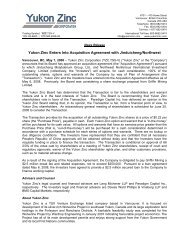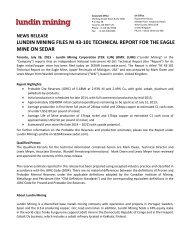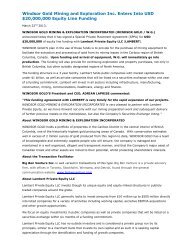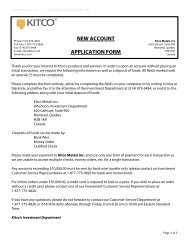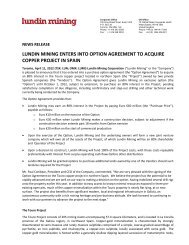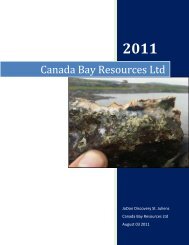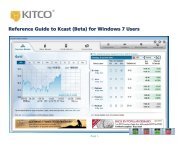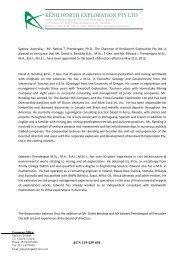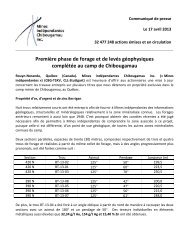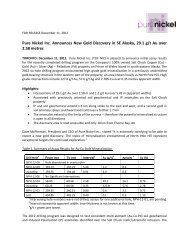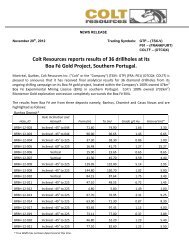Download Kitco's Rhodium Sponge MSDS document
Download Kitco's Rhodium Sponge MSDS document
Download Kitco's Rhodium Sponge MSDS document
You also want an ePaper? Increase the reach of your titles
YUMPU automatically turns print PDFs into web optimized ePapers that Google loves.
Material Safety Data Sheet<br />
RHODIUM POWDER <strong>MSDS</strong> No. 30000<br />
Section 1 - Chemical Product and Company Identification<br />
Product/Chemical Name: <strong>Rhodium</strong> Powder<br />
Chemical Formula: Rh<br />
CAS Number: 7440-16-6<br />
Trade Name: <strong>Rhodium</strong> Powder<br />
Chemical Family: Platinum group metal<br />
Manufacturer: Johnson Matthey, 2001 Nolte Drive, West Deptford, NJ 08066, USA<br />
Emergency Phone: (856) 384-7050<br />
Section 2 - Composition / Information on Ingredients<br />
Revision: 1/08/10<br />
Ingredient Name CAS Number % wt or<br />
% vol<br />
<strong>Rhodium</strong> 7440-16-6 100%<br />
Hazardous Ingredients:<br />
OSHA PEL ACGIH TLV<br />
TWA TWA<br />
Insoluble rhodium compound<br />
WARNING: Hazardous dust<br />
* Reported in EPA TSCA Inventory<br />
0.1 mg/m3 as Rh 1 mg/m3 as Rh<br />
Section 3 - Hazards Identification<br />
�������������������� Emergency Overview ��������������������<br />
Potential Health Effects<br />
Primary Entry Routes: Inhalation<br />
Target Organs: Not known<br />
Acute Effects<br />
Inhalation: Not known<br />
Eye: Mild irritation possible<br />
Skin: Mild irritation possible<br />
Ingestion: Not known<br />
Carcinogenicity: IARC, NTP, and OSHA do not list this product as a carcinogen.<br />
Medical Conditions Aggravated by Long-Term Exposure: No data<br />
Chronic Effects: None known<br />
Other: Non toxic by oral ingestion (LD50, rat >2000 mg/kg) and non-irritation to skin and eyes according to test on rabbits.<br />
Signs and symptoms of irritation are itching, redness and swelling, and in severe cases, burning and pain at the site of<br />
exposure. Irritation should stop when exposure id discontinued and first aid procedures are followed. There are no<br />
<strong>document</strong>ed effects of overexposure to <strong>Rhodium</strong> metal.<br />
Section 4 - First Aid Measures<br />
Inhalation: Remove to fresh air. If breathing has stopped, administer artificial respiration. If breathing is difficult, give<br />
oxygen. Get immediate medical attention.<br />
Eye Contact: Flush with water for at least 15 minutes including beneath eyelids. Remove contacts/glasses while flushing.<br />
Get immediate medical attention.<br />
Skin Contact: Wash area with soap and water while removing contaminated clothing. Wash for at least 15 minutes. Get<br />
immediate medical attention. Wash clothing/shoes thoroughly before reuse.<br />
Ingestion: Do not induce vomiting. Give person large amounts of water. Do not give anything to an unconscious<br />
person. Get immediate medical attention.<br />
Section 5 - Fire-Fighting Measures<br />
Johnson Matthey
<strong>MSDS</strong> No. 30000 RHODIUM POWDER revision: 1/08/10<br />
Flash Point: N/A, Non flammable<br />
Flash Point Method: Not applicable<br />
Autoignition Temperature: Not applicable<br />
LEL: Not applicable<br />
UEL: Not applicable<br />
Extinguishing Media: Water, foam, dry chemical, CO 2<br />
Unusual Fire or Explosion Hazards: There is a potential for fire when <strong>Rhodium</strong> dust is exposed to heat or flame. <strong>Rhodium</strong> will<br />
react violently with Chlorine triflouride and oxygen diflouride.<br />
Hazardous Combustion Products:<br />
Fire-Fighting Instructions: Do not release runoff from fire control methods to sewers or waterways.<br />
Fire-Fighting Equipment: Wear NIOSH/MSHA approved pressure demand self-contained breathing apparatus. Wear flame<br />
and chemical resistant clothing, hard hat, gloves and boots. Evacuate immediate area.<br />
Page 2 of 4<br />
Section 6 - Accidental Release Measures<br />
Spill /Leak Procedures: Prevent wastage; conserve, accumulate spent residues wipes, etc. for recovery of precious metal. Wear<br />
protective clothing as in Section 8.<br />
Containment: For large spills, dike far ahead of liquid spill for later disposal. Do not release into sewers or waterways.<br />
Cleanup: Return accumulated residues, wipes, mops, sand and vermiculite to refinery for metals recovery. Store material in inert<br />
containers such as polyethylene or polypropylene which have chemical identification and hazard warning information.<br />
Regulatory Requirements: Follow applicable federal, state and local regulations for packaging, labeling, manifesting,<br />
transportation and disposal.<br />
Section 7 - Handling and Storage<br />
Handling Precautions: Follow good industrial hygiene and housekeeping practices. Do not eat, drink or smoke while working<br />
with this material. Wash hands before eating, drinking, smoking or applying cosmetics and at the end of<br />
the work shift. Do not breathe dust or mist and do not get in eyes, on skin or on clothing. A shower and<br />
clothing policy should be established depending on the potential for exposure.<br />
Storage Requirements: Store in a cool, dry, secure area away from incompatible materials and conditions. Use proper labeling in<br />
accordance with 29 CFR 1910.1200.<br />
Section 8 - Exposure Controls / Personal Protection<br />
Engineering Controls:<br />
Ventilation:<br />
Local Exhaust: Fume hood at point of generation.<br />
Provide general or local exhaust ventilation systems to maintain airborne concentrations below OSHA PELs<br />
(Sec. 2). Local exhaust ventilation is preferred because it prevents contaminant dispersion into the work area by<br />
controlling it at its source.<br />
Administrative Controls:<br />
Respiratory Protection: If there is a possibility that the TLV's or PEL's may be exceeded, a NIOSH/MSHA approved full-face<br />
piece respirator with a high efficiency particulate filter cartridge is the recommended minimum level<br />
of respiratory protection. To ensure proper respirator selection and use, refer to the requirements of<br />
29 CFR 1910.134 and the latest edition of ANSI Z 88.2.<br />
Select respirator based on its suitability to provide adequate worker protection for given working<br />
conditions, level of airborne contamination, and presence of sufficient oxygen. For emergency or<br />
non-routine operations (cleaning spills, reactor vessels, or storage tanks), wear an SCBA.<br />
If respirators are used, OSHA requires a written<br />
respiratory protection program that includes at least: medical certification, training, fit-testing,<br />
periodic environmental monitoring, maintenance, inspection, cleaning, and convenient, sanitary<br />
storage areas.<br />
Protective Clothing/Equipment:<br />
Protective Gloves: Rubber, impervious gloves to chemicals and conditions encountered.<br />
Eye Protection: OSHA, ANSI approved safety goggles/glasses. Contact lenses are not protective devices. Appropriate eye-<br />
and face-protection must be worn instead of, or in conjunction with contact lenses.<br />
Protective Clothing: Wear disposable protective clothing to facilitate recovery of precious metal after spill. Protective clothing<br />
includes lab coat and apron, flame and chemical resistant coveralls, and boots/safety shoes to prevent<br />
prolonged or repeated skin contact.
evision: 1/08/10 RHODIUM POWDER <strong>MSDS</strong> No. 30000<br />
Safety Stations: Where there is a possibility that an employee’s eyes may be exposed to the product, an eyewash fountain<br />
should be provided within the immediate work area for emergency use. Safety drench shower and hygienic<br />
facilities are available in production areas.<br />
Comments: Follow good industrial hygiene and housekeeping practices. Do not eat, drink or smoke while working with<br />
this material. Wash hands before eating, drinking, smoking or applying cosmetics and at the end of the<br />
work shift. Do not breathe dust or mist and do not get in eyes, on skin or on clothing. A shower and<br />
clothing policy should be established depending on the potential for exposure.<br />
Physical State: Crystals or powder<br />
Appearance and Odor: gray powder; odor not known<br />
Odor Threshold: Not applicable<br />
Vapor Pressure: Not applicable<br />
Vapor Density (Air=1): Not applicable<br />
Formula Weight: 253.81<br />
Density: Not applicable<br />
Specific Gravity (H2O=1): Not applicable<br />
pH: Not applicable<br />
Stability: Stable<br />
Polymerization: Hazardous polymerization will not occur.<br />
Chemical Incompatibilities: None known<br />
Conditions to Avoid: None known<br />
Hazardous Decomposition Products: None known<br />
Eye Effects: Not known<br />
Skin Effects: Not known<br />
Ecotoxicity: Not known<br />
Environmental Fate: Not known<br />
Environmental Transport: Not known<br />
Environmental Degradation: Not known<br />
Soil Absorption/Mobility: Not known<br />
Section 9 - Physical and Chemical Properties<br />
Section 10 - Stability and Reactivity<br />
Section 11- Toxicological Information<br />
Toxicity Data:<br />
Water Solubility: Negligible.<br />
Other Solubilities: Insoluble in most solvents.<br />
Boiling Point: Not applicable<br />
Freezing/Melting Point: Melting - 1100°C decomp.<br />
Viscosity: Not applicable<br />
Refractive Index: Not applicable<br />
Surface Tension: Not applicable<br />
% Volatile: Not applicable<br />
Evaporation Rate: Not applicable<br />
Acute Inhalation Effects: Not known<br />
Acute Oral Effects: Not known<br />
Section 12 - Ecological Information<br />
Section 13 - Disposal Considerations<br />
Disposal: Return accumulated residues, wipes, mops, sand and vermiculite to precious metal refinery for metal recovery.<br />
Disposal Regulatory Requirements: Follow federal, state, and local regulations for packaging, labeling, manifesting,<br />
transportation and disposal.<br />
Shipping Name:<br />
Technical Name:<br />
Hazard Class:<br />
UN No.:<br />
Packing Group:<br />
Label:<br />
Canadian WHMIS Classification:<br />
Section 14 - Transport Information<br />
DOT Transportation Data (49 CFR 172.101):<br />
Non<br />
Hazardous<br />
Page 3 of 4
<strong>MSDS</strong> No. 30000 RHODIUM POWDER revision: 1/08/10<br />
Page 4 of 4<br />
Section 15 - Regulatory Information<br />
EPA Regulations:<br />
RCRA Hazardous Waste Number: Not listed (40 CFR 261.33)<br />
RCRA Hazardous Waste Classification (40 CFR 261): Not classified<br />
CERCLA Hazardous Substance (40 CFR 302.4), Sec. 3001; CWA, Sec. 311 (b)(4); CWA, Sec. 307(a), CAA, Sec. 112: Not listed<br />
CERCLA Reportable Quantity (RQ): None known<br />
SARA 311/312 Codes: Not listed<br />
SARA Toxic Chemical (40 CFR 372.65): Not listed<br />
SARA EHS (Extremely Hazardous Substance) (40 CFR 355): Not listed<br />
TSCA: Listed in TSCA Inventory<br />
OSHA Regulations:<br />
Air Contaminant (29 CFR 1910.1000, Table Z-1)<br />
State Regulations: None known<br />
Section 16 - Other Information<br />
Prepared By: Paul Vincent<br />
Revision Notes: Updated to the ANSI/CMA 16 Section <strong>MSDS</strong> Format on 7/16/01. Update ER phone number 11/14/07<br />
Disclaimer: Employers should use this information only as a supplement to other information gathered by them. and should make<br />
independent judgment of suitability of this information to ensure proper use and protect the health and safety of employees. This<br />
information is furnished without warranty, and any use of the product not in conformance with this Material Safety Data Sheet, or<br />
in combination with any other product or process, is the responsibility of the user.



